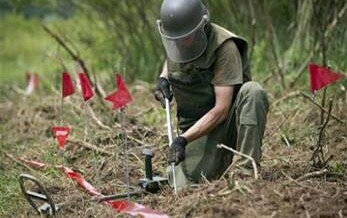
Guest Blog by Ted Paterson, October 3, 2016
Recent days have seen much ado concerning Canada’s renewed commitment to peacekeeping, but far less attention has been paid to our other diplomatic initiative that was worthy of a Nobel Prize, the Ottawa Treaty on landmines. This seems curious given the success of the Treaty and the accolades Canada received for its leadership twenty years ago.
Over 160 states have joined the Treaty, which has dramatically curtailed the use of anti-personnel landmines and virtually eliminated trade in these devices. It provided the model for the 2008 Oslo Treaty banning the use of cluster munitions. Over just the past decade, mine action – the work of mitigating the problems caused by mines, cluster munitions and other explosive remnants of war – has led to a 75% reduction in casualties and the clearance of 2,000 square kilometers of minefields, allowing the safe movement of refugees and humanitarian workers, the reconstruction of essential infrastructure and the expansion of farming. Specialized mine action NGOs and firms do most of the demining for peacekeeping missions and stabilization programmes, clean up abandoned stockpiles of weapons (keeping these away from extremists), and employ thousands of demobilized militia members, allowing them to reintegrate into society.
Given this success, Canada earned great respect for its support to mine action. With the signing of the Ottawa Treaty in 1997, the government established a $100 million Canadian Landmine Fund, together with units in CIDA, Foreign Affairs and Defence to manage the programme. The Fund was renewed with an additional $72 million in 2003, but discontinued in the aftermath of the 2008 financial crisis. Support to mine action collapsed, officials with mine action experience were transferred or retired, and Canada relinquished its leadership. We have not been among the top-10 donor countries to mine action since 2010; by 2014, our funding had fallen by over 80% from its peak.
Why did Canada turn its back on mine action? It’s not at all obvious that it fell victim to party politics. The Ottawa Treaty was an initiative of a Liberal government, but the Conservatives initially increased funding to mine action. There was some kerfuffle when the Harper Government passed cluster munitions legislation in 2015 that was not compliant with the Oslo Treaty, but the controversy soon passed and the political fallout was slight.
Nor is the collapse in Canadian funding due to a lack of results. Most evaluations have shown that mine action programmes deliver value for money. In fragile and conflict-affected states, mine action is typically the star performer. For one example, the conclusion to a recent evaluation of the UN Mine Action Service (UNMAS) support to the Mine Action Programme for Afghanistan (MAPA) starts with: “Few programmes can claim success in Afghanistan. The MAPA can. Few programmes can claim having an unquestionable humanitarian and development impact. The MAPA can. Few programmes can claim to be built on up-to-date data and robust analysis. The MAPA can. Few organisations can claim to have built technical and management capacities in a sustainable manner. UNMAS can.”
There doesn’t seem to be any clear reason why Canada dropped the ball on mine action. Perhaps it was just another casualty of that particularly feckless period when we chose to freeride on an array of foreign policy issues, including peacekeeping, the UN, and climate change.
As we well know, however, the Trudeau Government has missed no recent opportunity to trumpet that Canada is back on the international stage. We’ve taken in 30,000 Syrian refugees. The government recently committed up to 600 military personnel as peacekeepers and announced new support for peace and stabilization operations. Canada recently hosted a major international AIDS, tuberculosis and malaria conference.
But barely a whisper on mine action. If the government means to restore Canada’s reputation as a responsible member of the international community, it might start by meeting the responsibilities we assumed as midwife to the Ottawa Treaty.
Ted Paterson is a consultant specializing in mine action and development, and a senior fellow with the Norman Paterson School of International Affairs at Carleton University. The views expressed in this article are those of the author.
